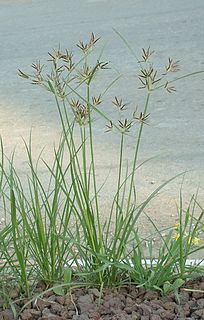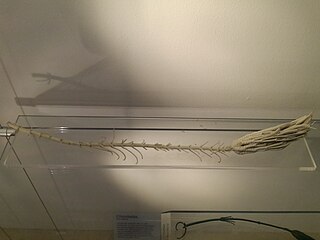
Convolvulaceae, known commonly as the bindweed or morning glory family, is a family of about 60 genera and more than 1,650 species of mostly herbaceous vines, but also trees, shrubs and herbs, and also including the sweet potato and a few other food tubers.

The Cyperaceae are a family of graminoid (grass-like), monocotyledonous flowering plants known as sedges. The family is large, with some 5,500 known species described in about 90 genera, the largest being the "true sedges" genus Carex with over 2,000 species.

Vampire bats, species of the subfamily Desmodontinae, are leaf-nosed bats found in Central and South America. Their food source is blood, a dietary trait called hematophagy. Three extant bat species feed solely on blood: the common vampire bat, the hairy-legged vampire bat, and the white-winged vampire bat. All three species are native to the Americas, ranging from Mexico to Brazil, Chile, Uruguay and Argentina.

Desmodus is a genus of bats which—along with the genera Diaemus and Diphylla—are allied as the subfamily Desmodontinae, the carnivorous, blood-consuming vampire bats of the New World leaf-nosed bat family Phyllostomidae.

Cyperus is a large genus of about 700 species of sedges, distributed throughout all continents in both tropical and temperate regions.

The common vampire bat is a small, leaf-nosed bat native to Latin America. It is one of three extant species of vampire bat, the other two being the hairy-legged and the white-winged vampire bats. The common vampire bat practices hematophagy, mainly feeding on the blood of livestock. The bat usually approaches its prey at night while they are sleeping. It then uses its razor-sharp teeth to cut open the skin of its hosts and lap up their blood with its long tongue.

Cyperus rotundus is a species of sedge (Cyperaceae) native to Africa, southern and central Europe, and southern Asia. The word cyperus derives from the Greek κύπερος, kyperos, and rotundus is from Latin, meaning "round". The earliest attested form of the word cyperus is the Mycenaean Greek 𐀓𐀞𐀫, ku-pa-ro, written in Linear B syllabic script.
Pachyballus is a genus of jumping spiders that was first described by Eugène Louis Simon in 1900. While most are found in Africa and nearby regions, one species is endemic to New Caledonia. The name is a combination of the Ancient Greek παχύς ("pachys"), meaning "thick", and the salticid genus Ballus.

Dissacus is a genus of extinct carnivorous jackal to coyote-sized mammals within the family Mesonychidae, an early group of hoofed mammals that evolved into hunters and omnivores. Their fossils are found in Paleocene to Early Eocene aged strata in France, Asia and southwest North America, from 66–50.3 mya, existing for approximately 15.7 million years .
Planiemen is a genus of jumping spider erected in 2007 for the sole species Planiemen rotundus, formerly placed in the genus Pachyballus. It is endemic to Yemen.

Bactra venosana, the nutgrass borer or nutsedge borer, is a moth of the family Tortricidae. It was first described by Philipp Christoph Zeller in 1847. It has a wide distribution, from southern Europe, North Africa and Asia Minor to India, Sri Lanka, southern China, Malaya, Australia and into the Pacific where it is found on Java, Borneo, the Philippines, Taiwan, Timor, the Solomons, the Carolines and Fiji. It was introduced to Hawaii in 1925 to control nutsedge. It is now found on Kauai, Oahu, Molokai, Maui, Lanai and Hawaii.
Euseius rotundus is a species of mite in the family Phytoseiidae.

Metacrinus is a genus of stalked crinoids in the family Isselicrinidae. Members of this genus live on hard surfaces in deeper parts of the ocean. The genus has extant species and is also represented in the fossil record. Members of the genus grow to a maximum height of 60 centimetres (24 in) and are found in the eastern Pacific Ocean from Japan to Australia.

Metacrinus rotundus, the Japanese sea lily, is a marine invertebrate, a species of stalked crinoid in the family Isselicrinidae. It is a species found off the west coast of Japan, and is living near the edge of the continental shelf, around 100-150m deep. This is the shallowest species among the extant stalked crinoids.
Crozetulus is a genus of African araneomorph spiders in the family Anapidae, first described by V. V. Hickman in 1939.
Oreonetides is a genus of dwarf spiders that was first described by Embrik Strand in 1901.
Sisis is a genus of North American sheet weavers that was first described by S. C. Bishop & C. R. Crosby in 1938. As of May 2019 it contains only two species, both found in Canada and the United States: S. plesius and S. rotundus.

Ambrysus is a genus of creeping water bugs in the family Naucoridae. There are more than 90 described species in Ambrysus.
Hypocryphalus is a genus of typical bark beetles in the family Curculionidae. There are more than 70 described species in Hypocryphalus.
Loricaster is a genus of minute beetles in the family Clambidae. There are at least three described species in Loricaster.










